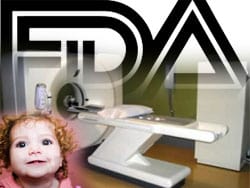
The Food and Drug Administration (FDA) hopes new guidelines for the use of radiation-emitting medical imaging tests like X-rays and CT (computed tomography) scans will help reduce a child patient’s exposure to radiation. Recent studies have suggested that use of radiation-emitting medical tests are used far too often, especially in the diagnosis of common conditions […]
 The Food and Drug Administration (FDA) hopes new guidelines for the use of radiation-emitting medical imaging tests like X-rays and CT (computed tomography) scans will help reduce a child patient’s exposure to radiation.
The Food and Drug Administration (FDA) hopes new guidelines for the use of radiation-emitting medical imaging tests like X-rays and CT (computed tomography) scans will help reduce a child patient’s exposure to radiation.
Recent studies have suggested that use of radiation-emitting medical tests are used far too often, especially in the diagnosis of common conditions suffered by children. It’s likely the average child will receive at least 7 tests that emit radiation before they reach their 18th birthday. This puts them at a greater risk of suffering toxic radiation exposure, something that could impair their brain and body development and increase their risk of possibly developing cancer in the future.
Unfortunately for children, there are no guidelines for treating children with these imaging tests and the FDA believes that following its new guidelines will help reduce the risk of radiation exposure. It has even urged the makers of X-ray and CT scan devices to develop child-friendly machines that require less radiation exposure or use to generate an effective scan. Additionally, the agency wants makers of currently used machines to develop warnings and issue guidance on the proper use of their devices on pediatric patients.
“The risk from a medically necessary imaging exam is quite small when compared to the benefit of accurate diagnosis or intervention. There is no reason for patients who need these exams to avoid them,” said Jeffrey Shuren, M.D., director of the FDA’s Center for Devices and Radiological Health, in a release from the agency. “Parents should engage in a discussion with their child’s physician about benefits and risks of X-ray, computed tomography (CT), and fluoroscopy exams.”
To help with developing these rules and future regulation of the use of X-rays and CT scans on pediatric patients in the future, the FDA has employed the aid of Alliance for Radiation Safety in Pediatric Imaging (ARSPI) and manufacturers, through the Medical Imaging and Technology Alliance (MITA). These groups are charged with developing the training and safety information for medical professionals specifically for using these tests in the future on children. The agency and these two groups have been working since February 2010 to develop these guidelines. In mid-July, the FDA has scheduled a workshop that will convene in Washington to discuss its proposed guidelines on the use of radiation scans for children. At that workshop are expected to be physicians, radiologic technologists, and physicists, according to the FDA’s release announcing the new guidelines.
The use of CT scans and X-rays is on a dramatic rise, with the tests being used almost as a go-to diagnosis method over traditional bedside care. Often, a doctor will order one of these tests on a new patient based on an initial analysis of a condition when more traditional care could produce the same diagnosis. Several factors could be causing a sharp rise in the use of X-rays, CT scans, fluoroscopy tests, and the like, including a doctor’s worries of potential malpractice charges for a missed diagnosis, a patient’s (or their insurance company’s) ability to pay for the scan, and pressure from healthcare facilities and device makers to use the tests as often as possible.


